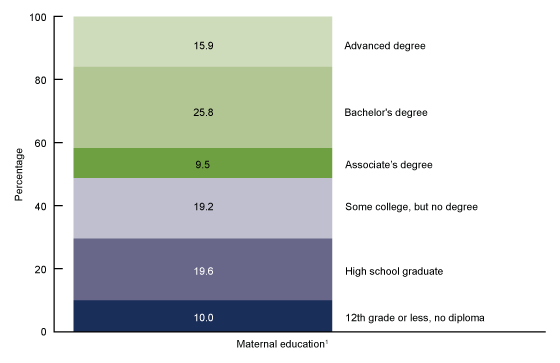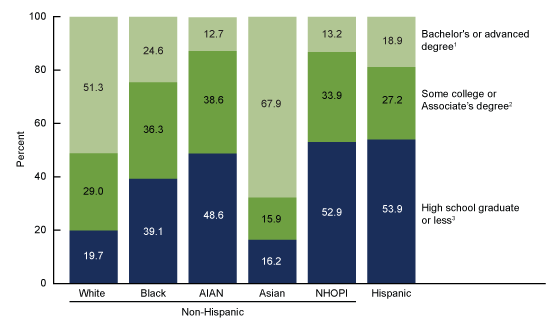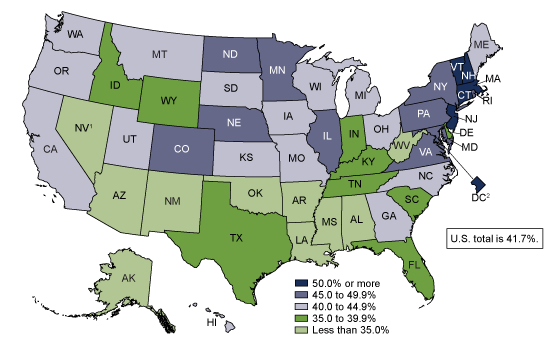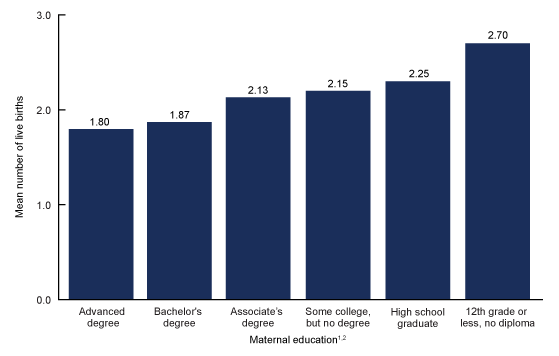Educational Attainment of Mothers Aged 25 and Over: United States, 2017
- Key findings
- Over 40% of births in 2017 were to mothers aged 25 and over with a Bachelor's or advanced degree.
- Non-Hispanic Asian mothers aged 25 and over were most likely to have a Bachelor’s or advanced degree in 2017.
- The percentage of mothers aged 25 and over who had a Bachelor's or advanced degree was 50% or higher in six jurisdictions.
- Among mothers aged 25 and over, the mean number of live births declined with increasing educational attainment.
- Summary
- Definitions
- Data source and methods
- About the authors
- References
- Suggested citation
NCHS Data Brief No. 332, February 2019
PDF Versionpdf icon (481 KB)
T.J. Mathews, M.S., and Brady E. Hamilton, Ph.D.
Key findings
Data from the National Vital Statistics System
- In 2017, 41.7% of mothers aged 25 and over had completed a Bachelor’s or advanced degree.
- Non-Hispanic Asian mothers aged 25 and over were the most likely of all race and Hispanic-origin groups to have a Bachelor’s or advanced degree (67.9%).
- Mothers in the District of Columbia were more likely to have a Bachelor’s or advanced degree (58.5%) compared with mothers in other U.S. jurisdictions.
- The mean number of births declined with advancing maternal education from 2.70 births for mothers with less than a 12th grade education, with no high school diploma, to just under 1.90 births for mothers with a Bachelor’s or advanced degree.
Maternal education has been shown to be associated with the number of children a woman has during her childbearing years, as well as maternal and infant health (1–5). Using 2017 national birth certificate data, this report describes educational attainment of mothers aged 25 and over, overall and by race and Hispanic origin and state, and the mean numbers of live births by mothers’ educational attainment.
Keywords: childbearing by education, live-birth order, race and Hispanic origin, maternal age, National Vital Statistics System
Over 40% of births in 2017 were to mothers aged 25 and over with a Bachelor’s or advanced degree.
- In 2017, mothers with an advanced degree (i.e., Master’s degree or doctorate) represented 15.9% of all births in the United States (Figure 1).
- The largest percentage of births by educational attainment was for mothers with a Bachelor’s degree (25.8%), followed by mothers who were high school graduates (19.6%), and mothers who had attended some college but had not received a degree (19.2%).
- The smallest percentage of births in 2017 was for mothers who attained an Associate’s degree (9.5%). The percentage of births to mothers with less than a high school degree was slightly higher (10.0%).
Figure 1. Percentage of births to mothers aged 25 and over, by educational attainment: United States, 2017
1Significant differences between all educational attainment levels (p < 0.05).
NOTES: Access data table for Figure 1pdf icon.
SOURCE: NCHS, National Vital Statistics System, Natality.
Non-Hispanic Asian mothers aged 25 and over were most likely to have a Bachelor’s or advanced degree in 2017.
- In 2017, non-Hispanic Asian mothers were most likely to have a higher education than women in any other race and Hispanic-origin group, with more than two-thirds having a Bachelor’s or advanced degree (67.9%) (Figure 2).
- More than one-half (51.3%) of non-Hispanic white mothers had a Bachelor’s or advanced degree at the time of birth, a higher percentage than non-Hispanic black (24.6%), Hispanic (18.9%), non-Hispanic Native Hawaiian or Other Pacific Islander (NHOPI) (13.2%), and non-Hispanic American Indian or Alaska Native (AIAN) mothers (12.7%).
- Among all race and Hispanic-origin subgroups, Hispanic and non-Hispanic NHOPI mothers were most likely to have a high school degree or less (53.9% and 52.9%, respectively).
- Non-Hispanic Asian mothers were least likely (16.2%) to have a high school degree or less at the time of birth.
Figure 2. Percentage of births to mothers aged 25 and over, by educational attainment and race and Hispanic origin: United States, 2017
1Significant differences between groups except between non-Hispanic AIAN and non-Hispanic NHOPI (p < 0.05).
2Significant differences between groups (p < 0.05).
3Significant differences between groups except between non-Hispanic NHOPI and Hispanic (p < 0.05).
NOTES: AIAN is American Indian or Alaska Native. NHOPI is Native Hawaiian or Other Pacific Islander. Figures may not total to 100 percent due to rounding. Access data table for Figure 2pdf icon.
SOURCE: NCHS, National Vital Statistics System, Natality.
The percentage of mothers aged 25 and over who had a Bachelor’s or advanced degree was 50% or higher in six jurisdictions.
- In 2017, the percentage of births to mothers with a Bachelor’s or advanced degree was highest in the District of Columbia (58.5%) (Figure 3). States with more than 50% of births to mothers with a Bachelor’s or advanced degree include: Connecticut, Massachusetts, New Hampshire, New Jersey, and Vermont.
- In 10 states (Alabama, Alaska, Arizona, Arkansas, Louisiana, Mississippi, Nevada, New Mexico, Oklahoma, and West Virginia), less than 35% of mothers had a Bachelor’s or advanced degree.
- Nevada had the lowest percentage of mothers with a Bachelor’s or advanced degree (26.6%) and New Mexico had the second lowest (28.8%).
Figure 3. Percentage of births to mothers aged 25 and over with a Bachelor’s or advanced degree, by state: United States, 2017
1Significant difference between the lowest jurisdiction (NV) and all other jurisdictions (p < 0.05).
2Significant difference between the highest jurisdiction (DC) and all other jurisdictions (p < 0.05).
NOTE: Access data table for Figure 3pdf icon.
SOURCE: NCHS, National Vital Statistics System, Natality.
Among mothers aged 25 and over, the mean number of live births declined with increasing educational attainment.
- The mean number of live births was highest among mothers with less than a high school education (2.70) in 2017 (Figure 4).
- The mean number of live births then declined to 2.25 for mothers with a high school diploma, to 2.15 for mothers with some college but no degree, and then to 2.13 for mothers with an Associate’s degree.
- The lowest mean numbers of live births were for mothers with a Bachelor’s degree (1.87) and with an advanced degree (1.80).
Figure 4. Mean number of live births to mothers aged 25 and over, by educational attainment: United States, 2017
1Significant negative relationship with increasing educational attainment (p < 0.05).
2Significant differences between all educational attainment levels (p < 0.05).
NOTE: Access data table for Figure 4pdf icon.
SOURCE: NCHS, National Vital Statistics System, Natality.
Summary
In 2017, 41.7% of mothers aged 25 and over giving birth in the United States had a Bachelor’s or advanced degree. Of the six race and Hispanic-origin groups, non-Hispanic Asian mothers were most likely to have a Bachelor’s or advanced degree (67.9%). The District of Columbia had the highest percentage of births to mothers with a Bachelor’s or advanced degree (58.5%), whereas Nevada had the lowest (26.6%). The mean number of births declined with increasing maternal educational attainment.
National birth certificate data on maternal educational attainment became available in 2016. From 2003 to 2015, during implementation of the 2003 U.S. Standard Certificate of Live Birth among jurisdictions, comparable data on the education level of women giving birth for all states were not available. Accordingly, this publication is the first to report on the education of all mothers in the United States in more than 20 years (6). This report presents general descriptive tabulations of births by educational attainment, including the percentages of birth by educational attainment, race and Hispanic origin, and by state of residence of the mother, and the mean number of births by educational attainment of mother. A forthcoming report will present more detailed tabulations of births by maternal education level, and will include birth rates by educational attainment.
Definitions
Educational attainment: The highest degree or level of school completed by the mother at the time of birth; this information is self-reported by the mother. The education categories are 8th grade or less; 9th through 12th grade, with no diploma; high school graduate or GED completed; some college, but no degree; Associate’s degree; Bachelor’s degree; Master’s degree; and Doctorate or other professional degree.
Data source and methods
This report is based on 2017 data from the Natality Data File from the National Vital Statistics System (NVSS). The vital statistics natality file is derived from birth certificates and includes information for all births occurring in the United States. The birth data set is the primary data set for analyzing birth trends and patterns in the United States.
The previous revision of the standard birth certificate collected years of education, which is not comparable with the current education item that collects data on educational degrees. This precludes any trend analysis of national birth data on maternal education.
Race and Hispanic origin are reported separately on birth certificates. Persons of Hispanic origin may be of any race. Persons of non-Hispanic origin are further classified by race because of differences in fertility and maternal characteristics between Hispanic and non-Hispanic persons. The race and Hispanic-origin groups shown in this report are based on the 1997 Office of Management and Budget standards (7). All non-Hispanic race groups shown here are single race.
References to differences in percentages in Figures 1 and 2 or means in Figure 4 indicate that the differences are statistically significant at p < 0.05., based on a two-tailed z test. In Figure 3, references to differences between the highest or lowest percentages indicate that the differences are statistically significant at p < 0.05., based on a two-tailed z test. The relationship between mean number of births and maternal educational attainment was evaluated using the Pearson’s correlation test and the negative relationship is statistically significant at p < 0.05. Computations of percents and means exclude records for which information is unknown or not stated.
About the authors
T.J. Mathews and Brady E. Hamilton are with the National Center for Health Statistics, Division of Vital Statistics, Reproductive Statistics Branch.
References
- Ruiz M, Goldblatt P, Morrison J, Kukla L, Švancara J, Riitta-Järvelin M, et al. Mother’s education and the risk for preterm and small for gestational age birth: A DRIVERS meta-analysis of 12 European cohorts. J Epidemiol Community Health 69(9):826–33. 2015.
- Zang E. Women’s educational attainment and fertility in the United States among generation Xersexternal icon. SocArXiv. 2018.
- Hazan M, Zoabi H. Do highly educated women choose smaller families? Econ J 125(587):1191–1226. 2015.
- Silva LM, Jansen PW, Steegers EA, Jaddoe VW, Arends LR, Tiemeier H, et al. Mother’s educational level and fetal growth: The genesis of health inequalities. Int J Epidemiol 39(5):1250–61. 2010.
- James-Todd T, Janevic T, Brown FM, Savitz DA. Race/ethnicity, educational attainment, and pregnancy complications in New York City women with pre-existing diabetes. Paediatr Perinat Epidemiol 28(2):157–65. 2014.
- Mathews TJ, Ventura SJ. Birth and fertility rates by educational attainment: United States, 1994. Monthly Vital Statistics Reports; vol 45 no 10, supp. Hyattsville, MD: National Center for Health Statistics. 1997.
- Office of Management and Budget. Revisions to the standards for the classification of federal data on race and ethnicity. Fed Regist 62(210):58782–90. 1997.
Suggested citation
Mathews TJ, Hamilton BE. Educational attainment of mothers aged 25 and over: United States, 2017. NCHS Data Brief, no 332. Hyattsville, MD: National Center for Health Statistics. 2019.
Copyright information
All material appearing in this report is in the public domain and may be reproduced or copied without permission; citation as to source, however, is appreciated.
National Center for Health Statistics
Jennifer H. Madans, Ph.D., Acting Director
Jennifer H. Madans, Ph.D., Associate Director for Science
Division of Health Care Statistics
Steven Schwartz, Ph.D., Director
Hanyu Ni, Ph.D., M.P.H., Associate Director for Science



